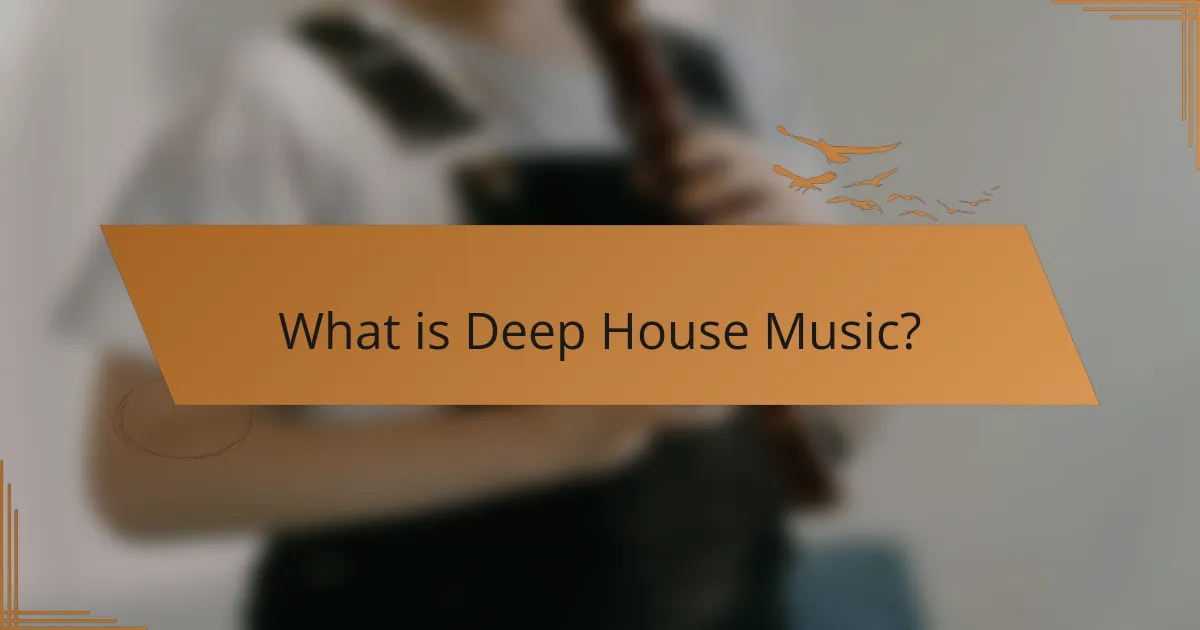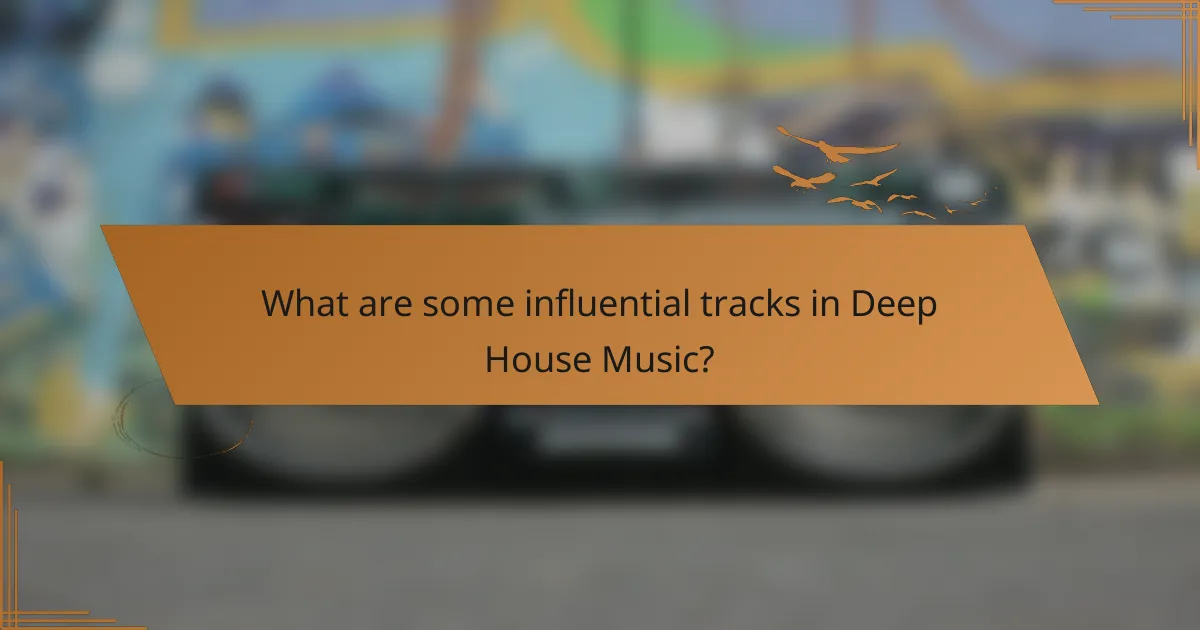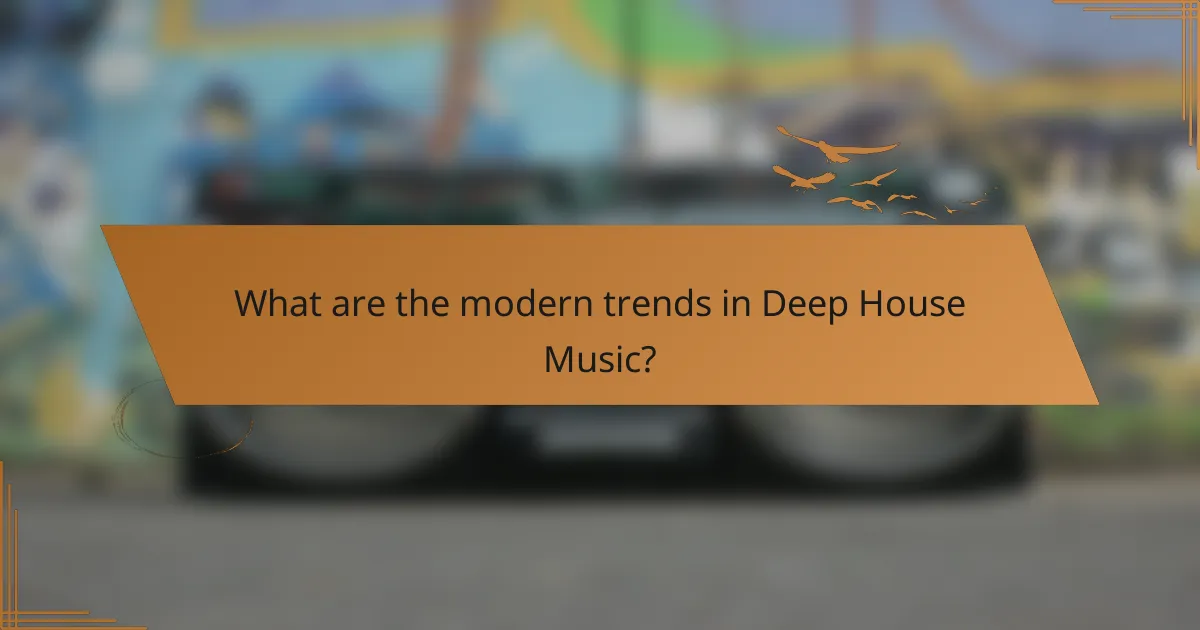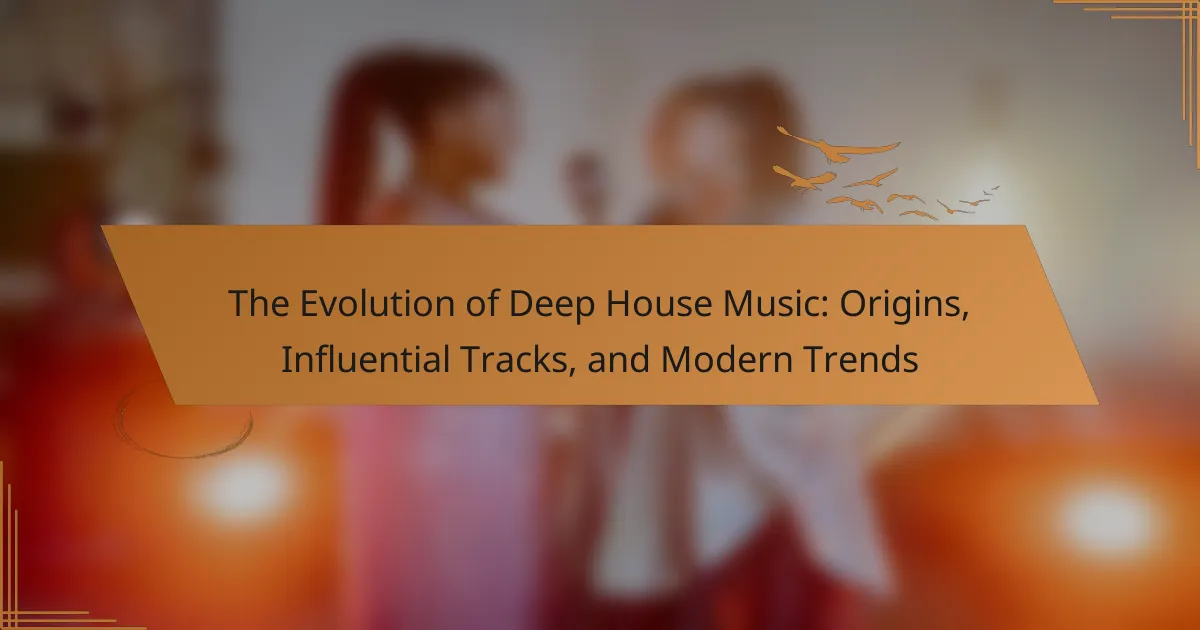Deep house music is a subgenre of house music known for its complex melodies and deep basslines, originating in the 1980s with influences from jazz, soul, and funk. The genre features slower tempos, atmospheric sounds, and smooth vocals, contributing to a laid-back vibe. Key artists like Larry Heard and Kerri Chandler have played significant roles in its development, while influential tracks such as “Can You Feel It,” “Deep Burnt,” and “Finally” have shaped its evolution. Modern trends in deep house include genre fusion, the use of live instrumentation, and a focus on emotional depth, reflecting its ongoing transformation in contemporary culture and its enduring popularity in clubs and festivals worldwide.

What is Deep House Music?
Deep house music is a subgenre of house music characterized by its complex melodies and deep basslines. It emerged in the 1980s, combining elements of jazz, soul, and funk. The genre typically features slower tempos, around 120 to 125 beats per minute. Deep house often includes atmospheric sounds and smooth vocals, creating a laid-back vibe. Notable artists include Larry Heard and Kerri Chandler, who significantly influenced its development. The genre has evolved over the years, incorporating various styles and technological advancements. Today, deep house remains popular in clubs and festivals worldwide. Its impact on electronic music is profound, shaping the sound of contemporary dance music.
How did Deep House Music originate?
Deep House Music originated in the 1980s in Chicago. It emerged as a subgenre of house music, characterized by its soulful vocals and complex melodies. Influential DJs and producers like Frankie Knuckles played a significant role in its development. The genre blends elements of jazz, soul, and funk, creating a smooth, atmospheric sound. Early tracks often featured deep basslines and synthesized chords. The genre gained popularity in clubs, especially in the underground scene. By the 1990s, Deep House had spread to Europe, influencing a new wave of artists. Its evolution continues today, with modern producers incorporating various styles and technologies.
What influences shaped the early sounds of Deep House Music?
The early sounds of Deep House Music were shaped by various influences, primarily Chicago house, jazz, and soul music. Chicago house provided the foundational beats and rhythms that characterized the genre. Jazz elements introduced complex chord progressions and improvisational styles. Soul music contributed emotive vocals and rich melodies. These influences combined to create a unique sound that emphasized groove and atmosphere. The use of synthesizers and drum machines also played a crucial role in defining the sound. Artists like Frankie Knuckles and Larry Heard were pivotal in this evolution. Their tracks often blended these influences seamlessly, establishing Deep House as a distinct genre in the music landscape.
What cultural movements contributed to the development of Deep House Music?
Deep House Music emerged from several cultural movements. The Chicago House scene in the early 1980s laid the foundation. It was characterized by its use of soulful vocals and jazz-influenced melodies. The disco movement also played a significant role, emphasizing rhythm and danceability. Additionally, the underground club culture contributed to its development, fostering a community around electronic music. The influence of African American culture is evident in its sound and style. The blending of these movements created a unique genre that resonates with many today.
What are the key characteristics of Deep House Music?
Deep House Music is characterized by its smooth, soulful sound and deep basslines. It typically features slower tempos, generally between 120 to 125 BPM. The genre incorporates elements of jazz, funk, and soul, creating a rich auditory experience. Vocals in deep house are often soft and melodic, enhancing the emotional depth of the tracks. Additionally, deep house utilizes lush synths and atmospheric pads, contributing to its immersive quality. The genre often includes intricate, layered production techniques, making it distinct from other house music styles. Historically, deep house emerged in the 1980s, influenced by Chicago house and Detroit techno. Its evolution has led to various sub-genres and modern interpretations, maintaining its relevance in contemporary electronic music.
How does the tempo and rhythm define Deep House Music?
Deep House Music is characterized by a tempo typically ranging from 120 to 125 beats per minute. This moderate tempo creates a laid-back and groovy feel. Rhythm in Deep House often features syncopated basslines and smooth, flowing percussion. These elements contribute to the genre’s signature soulful and atmospheric vibe. The use of extended chords and jazzy influences further enhances its emotional depth. Historical context shows that the genre emerged in the 1980s, influenced by Chicago house and jazz music. The combination of tempo and rhythm establishes a unique sound that distinguishes Deep House from other electronic music genres.
What instrumentation is commonly used in Deep House tracks?
Deep House tracks commonly utilize synthesizers, drum machines, and basslines. Synthesizers create lush pads and melodic elements. Drum machines provide the rhythmic foundation, often using 4/4 beats. Basslines are typically deep and smooth, enhancing the groove. Additionally, vocal samples and effects like reverb and delay are frequently incorporated. These elements contribute to the genre’s signature sound. The combination of these instruments creates a rich auditory experience characteristic of Deep House music.

What are some influential tracks in Deep House Music?
“Some influential tracks in Deep House music include ‘Can You Feel It’ by Mr. Fingers, ‘Deep Burnt’ by Pepe Bradock, and ‘Finally’ by Kings of Tomorrow. ‘Can You Feel It’ is often credited with shaping the genre’s sound in the 1980s. ‘Deep Burnt’ introduced a unique blend of jazz and house elements. ‘Finally’ became a classic anthem in the early 2000s, showcasing the emotional depth of deep house. These tracks have significantly impacted the genre’s evolution and popularity.”
Which tracks are considered seminal in the Deep House genre?
“Can You Feel It” by Mr. Fingers is considered a seminal track in the Deep House genre. Released in 1986, it helped define the sound of Deep House. The track features a smooth bassline and atmospheric synths. It is often credited with influencing many artists in the genre. Another seminal track is “Your Love” by Frankie Knuckles. This 1986 release is recognized for its emotional depth and melodic structure. “Deep Burnt” by Pepe Bradock is also pivotal. It showcases the genre’s ability to blend jazz elements with house music. These tracks are foundational to the development of Deep House. They continue to be celebrated and sampled by contemporary artists.
What impact did these tracks have on the evolution of Deep House Music?
Influential tracks significantly shaped the evolution of Deep House Music. They introduced new rhythms and production techniques. Tracks like “Can You Feel It” by Mr. Fingers popularized the use of soulful vocals. This blend created a deeper emotional connection for listeners. Additionally, “Your Love” by Frankie Knuckles established the genre’s signature basslines. These elements became foundational in defining Deep House. Over time, these tracks influenced subsequent artists and producers. They paved the way for modern interpretations of the genre. The impact is evident in the continued popularity of Deep House today.
How do these influential tracks reflect the essence of Deep House Music?
Influential tracks reflect the essence of Deep House Music through their signature sound and emotional depth. These tracks typically feature smooth, soulful melodies combined with deep basslines. The use of vocal samples adds a human touch, enhancing the emotional connection. Additionally, the incorporation of jazzy chords and atmospheric pads creates a lush soundscape. Many influential tracks also emphasize a steady four-on-the-floor beat, which is foundational to the genre. This rhythmic consistency allows for extended mixing and dancing. Tracks like “Can You Feel It” by Mr. Fingers and “Deep Burnt” by Pepe Bradock exemplify these characteristics. Their enduring popularity showcases the genre’s ability to evoke feelings of nostalgia and euphoria.
What artists have shaped the Deep House Music landscape?
Artists who have shaped the Deep House Music landscape include Larry Heard, Kerri Chandler, and Frankie Knuckles. Larry Heard, known as Mr. Fingers, pioneered the genre in the 1980s. His track “Can You Feel It” is considered a classic. Kerri Chandler is recognized for his soulful sound and deep grooves. His contributions include tracks like “Bar A Thym.” Frankie Knuckles, often called the “Godfather of House,” played a crucial role in the genre’s development. His remix of “Your Love” remains influential. Other notable artists include Maya Jane Coles and Disclosure, who brought modern elements to the genre. These artists have collectively defined and evolved Deep House music.
Who are the pioneers of Deep House Music?
The pioneers of Deep House Music include Larry Heard, Frankie Knuckles, and Mr. Fingers. Larry Heard, known for his track “Can You Feel It,” helped define the genre’s sound. Frankie Knuckles, often referred to as the “Godfather of House,” played a significant role in popularizing Deep House in Chicago. Mr. Fingers, another alias of Larry Heard, contributed with tracks like “Mystery of Love.” These artists laid the groundwork for Deep House’s distinct blend of soulful melodies and electronic beats. Their influence continues to resonate in today’s music scene, shaping the evolution of the genre.
What contemporary artists are redefining Deep House Music today?
Contemporary artists redefining Deep House Music today include Black Coffee, Peggy Gou, and Lane 8. Black Coffee is known for his unique blend of Afro-house elements with deep house. He has gained international acclaim and has a significant following. Peggy Gou brings a fresh perspective with her Korean influences and vibrant productions. Lane 8 emphasizes emotional storytelling in his tracks, creating immersive experiences. Each of these artists has contributed to the evolution of the genre, pushing boundaries and introducing innovative sounds. Their work is supported by a growing fan base and recognition in major music festivals.

What are the modern trends in Deep House Music?
Modern trends in deep house music include a fusion of genres, increased use of live instrumentation, and a focus on emotional depth. Producers are blending elements from techno, jazz, and ambient music. This creates a more diverse sound palette. Live instruments are being incorporated to enhance authenticity. Artists often use vocals that evoke strong emotional responses. Collaborations with artists from different genres are becoming more common. Digital platforms are facilitating the rise of new talent. This accessibility is reshaping the deep house landscape. Additionally, the emphasis on immersive experiences in live performances is growing. These trends reflect the evolving nature of deep house music in contemporary culture.
How has technology influenced Deep House Music production?
Technology has significantly influenced Deep House Music production by enhancing sound design and accessibility. Digital Audio Workstations (DAWs) allow producers to create complex arrangements easily. Software synthesizers and plugins provide a vast array of sounds and effects. This accessibility has democratized music production, enabling more artists to enter the genre. MIDI technology facilitates precise control over musical elements. Sampling technology allows the incorporation of diverse sounds and influences into tracks. Additionally, online platforms have transformed distribution and promotion, broadening audience reach. These advancements have collectively shaped the contemporary sound and production techniques within Deep House Music.
What role do digital platforms play in the distribution of Deep House Music?
Digital platforms are crucial for the distribution of Deep House Music. They provide artists with direct access to global audiences. Services like Spotify and SoundCloud allow for easy sharing and streaming. These platforms enable artists to reach listeners without traditional gatekeepers. Additionally, they facilitate data analytics for artists to understand their audience. This data helps in tailoring marketing strategies effectively. The rise of digital platforms has transformed how music is consumed and promoted. In 2021, over 80% of music revenue came from digital sources, highlighting their significance.
How has the rise of streaming services changed the Deep House Music scene?
The rise of streaming services has significantly transformed the Deep House Music scene. Streaming platforms have increased accessibility for both artists and listeners. Artists can now share their music globally without traditional barriers. This has led to a surge in new Deep House talent. Listeners can discover a diverse range of tracks with ease. Streaming algorithms also promote niche genres like Deep House. This has resulted in greater visibility for the genre. According to a 2021 report by the International Federation of the Phonographic Industry, streaming accounted for 62% of global music revenue. This shift has fostered a vibrant online community around Deep House music.
What are the current sub-genres within Deep House Music?
Current sub-genres within Deep House Music include Ambient Deep House, Soulful Deep House, and Tech Deep House. Ambient Deep House emphasizes atmospheric sounds and smooth melodies. Soulful Deep House incorporates elements of jazz and funk, featuring rich vocal performances. Tech Deep House blends deep house with techno, focusing on rhythmic elements and minimalism. Other notable sub-genres are Afro Deep House, known for its African rhythms, and Dub Techno, which adds a dub influence to deep house. These sub-genres reflect the diversity and evolution within the deep house music scene.
How do these sub-genres differ from traditional Deep House Music?
Sub-genres of Deep House Music differ from traditional Deep House in several key aspects. These variations often include changes in tempo, instrumentation, and overall sound. For example, tech house incorporates elements of techno, resulting in a more percussive and driving beat. In contrast, soulful house emphasizes vocal elements and rich harmonies, diverging from the minimalist approach of traditional Deep House. Furthermore, ambient house focuses on atmospheric sounds, creating a more immersive listening experience. Each sub-genre retains some foundational characteristics but introduces unique attributes that distinguish them from traditional Deep House.
What trends are emerging within these sub-genres?
Emerging trends within deep house sub-genres include a focus on organic sounds and live instrumentation. Producers are increasingly incorporating acoustic elements into their tracks. This trend creates a warmer and more authentic listening experience. Additionally, there is a rise in vocal collaborations, with artists blending genres like soul and R&B. This fusion attracts a broader audience and enhances emotional engagement. Another trend is the use of atmospheric soundscapes, which adds depth and texture to the music. Many tracks now feature ambient sounds and field recordings. The shift towards slower tempos is also notable, promoting a more relaxed vibe. These trends reflect a desire for authenticity and emotional connection in deep house music.
How can one appreciate and explore Deep House Music today?
To appreciate and explore Deep House Music today, listen to curated playlists on streaming platforms. Services like Spotify and Apple Music offer dedicated Deep House playlists. Attend live events or festivals featuring Deep House artists. Engaging with the community enhances the experience. Follow influential Deep House DJs on social media for updates. Explore online forums and discussion groups focused on Deep House. Research the genre’s history and influential tracks to gain context. Understanding its roots deepens appreciation for modern interpretations.
What are some recommended playlists or compilations for new listeners?
Recommended playlists for new listeners of deep house music include “Deep House Essentials” and “Chill Deep House.” These compilations feature foundational tracks that define the genre. “Deep House Essentials” includes influential artists like Larry Heard and Kerri Chandler. “Chill Deep House” focuses on a more relaxed vibe, perfect for newcomers. Additionally, platforms like Spotify and Apple Music curate playlists that highlight trending deep house tracks. These playlists help listeners discover both classic and contemporary deep house music.
How can attending live events enhance the experience of Deep House Music?
Attending live events enhances the experience of Deep House Music by providing an immersive atmosphere. The energy of a live crowd amplifies the emotional impact of the music. Artists often perform unique remixes or live edits that differ from studio recordings. This creates a sense of exclusivity and excitement for attendees. Additionally, visual elements such as lighting and stage design further enrich the overall experience. Engaging with other fans fosters a sense of community and shared enjoyment. Studies show that live music can increase dopamine levels, enhancing pleasure. Overall, the combination of sound, visuals, and social interaction makes live events a powerful way to experience Deep House Music.
Deep house music is a subgenre of house music that originated in the 1980s in Chicago, characterized by complex melodies, deep basslines, and soulful vocals. The article explores its evolution, key influences, and notable artists, including pioneers like Larry Heard and Frankie Knuckles, as well as contemporary figures such as Black Coffee and Peggy Gou. It highlights significant tracks that shaped the genre, discusses modern trends and sub-genres, and examines the impact of technology and digital platforms on deep house music today. The article serves as a comprehensive overview of deep house music’s history, characteristics, and ongoing relevance in the electronic music scene.
